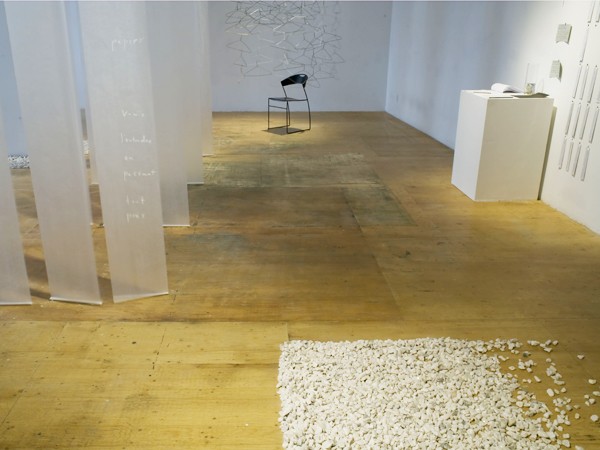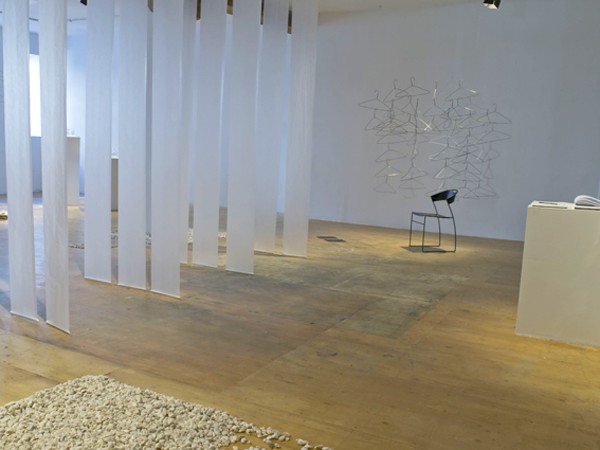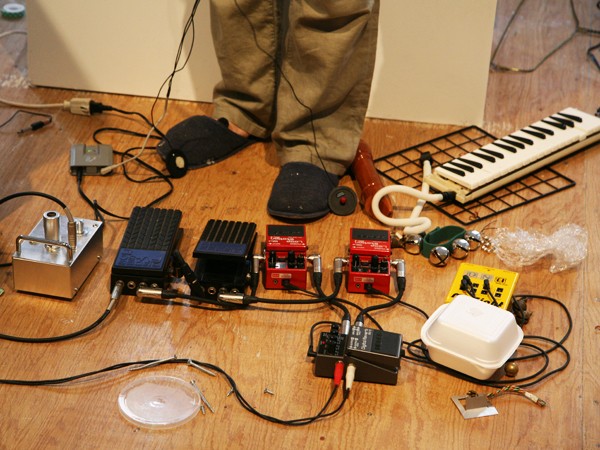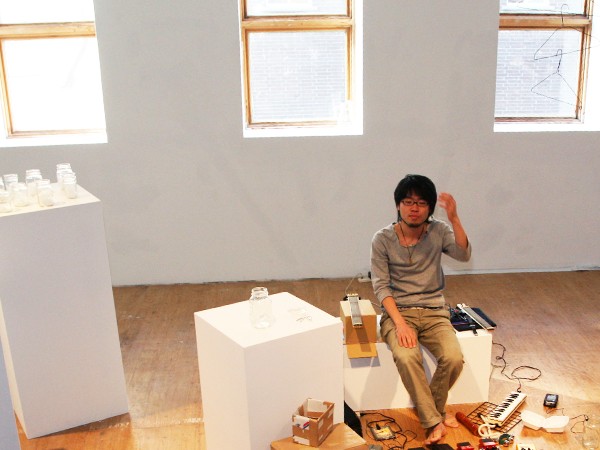when two things meet
they vibrate the air
and
they make sound
attack – decay – sustain – release
As I visit the city and the people
Let me vibrate your ears
I will leave as the sound disappear
Sound – a trace of existence –
– a sign of visitation –
The series of works entitled Étude, by the Japanese artist Mamoru Okuno, explored the musical and sonorous properties of everyday objects. The artist’s unusual approach to working with ordinary items such as coat-hangers, glass jars and straws transformed them into surprising sources of sound. With their usual function set aside, the artist’s actions transformed the objects into sound works. In this sense, Étude was an exploration of the spectrum of sound that is obscured in everyday life, and a reflection on the notion of value. “What determines the value of something,” asks the artist. In Étude, this questioning focuses on the sublimation of the everyday, drawing the spectator in by inviting him/her to experiment with the works created by the artist, and to discover the poetry that exists beyond convention and norms.
Attack
During his residency at LA CHAMBRE BLANCHE, Okuno used the series Études as a means of meeting the public. Before coming to town, he proposed structuring his studio work around meetings with Quebec residents. His goal was to share ideas, and on occasions objects, in a spirit of exchange and complicity.
Without delay, the artist took to exploring the city, seeking out a public curious to discover this artist who had come from so far away. A simple process of establishing contact began, based on participation in the project, its values and its sense of difference, reflecting a shared desire for meeting. Okuno presented participants with Étude no 7 / plastic straw, a multiple that he had produced industrially, using a straw of the kind found in fast-food chains.
This modest and normally disposable object came wrapped in colorful packaging designed by the artist, and was signed “Okuno.” Recipients were both amused and seduced by the simplicity of the work; some readily, and others more hesitantly, played the game of blowing into the straw. The sounds produced by blowing in the plastic tubes ranged from the melodious to the shrill. The process was both novel and elementary, revealing a kind of poetry of the ordinary. The immediacy of the situation was complemented by non-verbal modes of communication, expressing a desire to experience essence and a need for collective encounters.
Participants also showed their readiness to engage with Étude no. 12 /plastic film, a work consisting of sections of plastic food wrapping carefully pushed into two small, transparent acrylic cubes. The size of the work invited interaction, which took the form of pushing bubbles of ‘Saran Wrap’ to the bottom of the cube, and holding the structure up to one’s ears to listen to the sound produced by this action. The two cubes were presented in an attractive walnut-colored wooden box, bearing the title of the work and the artist’s name, creating the effect of a precious object or expensive jewelery case.
The strategies used by the artist to transform everyday objects into works of art were reminiscent of the subtlety of Duchamp’s work, if not the scandal. In 1917, this French artist presented an upside-down urinal in New York’s Armory Show, dating and signing the object R. Mutt. A heresy in its time, this “ready-made” was rapidly recuperated by other artists (amongst them, the surrealists and later the minimalists) in a lineage that continues to this day in the work of Okuno. That said, the question of the value of the Études did not reside in their status as elevated objects of everyday life, but rather in their propositional nature relating to the experience that they offered participants in the residency project.
Decay
Visits to Okuno’s residency project were also an occasion for the artist to collect items for potential use in the work. With an assurance that the items would be returned, Okono borrowed metal coat-hangers and glass jars from visitors, and introduced them into the exhibition space where they became ‘sound stations’, adding to the series.
So it was that Étude no 11 / hangers invited visitors to the gallery to let themselves drift amidst an ensemble of coat-hangers, suspended with nylon thread in the air, and carefully arranged around a chair, offering a seating place from which to enjoy the subtle sounds of the hangers as they moved against one another. In Étude no 21 /wax paper, strips of waxed paper were hung in groups of three from the ceiling, rubbing up against each other to produce sounds similar to leaves rustling in the wind. Elsewhere in the space, in Étude no 9 / stones and shoes visitors were invited to step on small white stones placed on the floor, creating friction sounds.
The diverse elements in the installation evoked a Japanese garden, and were placed in the space in such a way as to create a rhythmic journey, of both movement and moments of pause. The work as a whole seemed to be speak of an unchanging order, but in fact each station drew visitors in, and was activated by their presence. The objects featured in Études seemed to lose their form and specificity against the white backdrop of the exhibition space, turning instead into fascinating musical boxes.
Sustain
Okuno punctuated the timeframe of his residency with public sound performances using a range of transformer devices, further pursuing his exploration of sonorous forms. His sound performances were presented in the form of simple actions employing contemporary materials as, surrounded by objects, the artist improvised. Okuno allowed the sounds to flow and combine, using the transformers to amplify and loop the tones. Rather than seeking to create arrangements, he focused on the character and expressive potential of the sounds, individually and as an ensemble. The artist aimed for neither sophistication nor melody, preferring to focus on the raw qualities of the sounds produced. This resulted in a form of music that required a similar attentiveness to that of the actions of John Cage. This American composer was responsible for introducing a change of direction in the art world, creating a fracas similar to that caused by Duchamp several decades before. Cage’s 4’33, interpreted by David Tudor in 1952, consists of the background noises in the concert hall in which it is presented. The musician simply rests his or her hands on the piano keyboard, without playing a single note. In the case of Okuno’s work, the silence in the work related to the concentration required by visitors appreciate the music produced by everyday forms.
Release
In contrast to the artist’s use of improvisation, the final days of Okuno’s residency involved the orchestration of a closing signature work. The artist concluded his physical exchange at LA CHAMBRE BLANCHE by returning the objects that he had borrowed to their owners. In an event resembling a waterfall of sound, he invited participants to return to the space to witness a final sound work.
The artist had placed the glass jars on the floor of the space, arranging them in a way that corresponded to the distances that he had covered during his residency. One by one, visitors were invited to approach the jar representing their home. The artist proceeded to hand individuals an ice cube, in which a thread was partially enclosed, leading to a hook. Following the artist’s instructions, participants attached their ice cube to another thread that the artist had suspended over each of the jars. Once all the participants had completed the process of creating this delicate installation, Okuno invited them to approach the thread and listen closely. All were silent, listening out for the barely audible sound of drops of water falling from the ice cubes and into their respective jars. All that remained was to applaud!
Following the sounds produced by this arrangement of objects, Okuno began to dismantle his assemblage for the last time. Cutting the cords suspending the series of coat-hangers from the ceiling, he handed the items to participants with a discrete word and hand gesture of thanks. Echoing the conductor of an orchestra, Okuno concluded with the tap of a baton, before turning to thank the audience.




